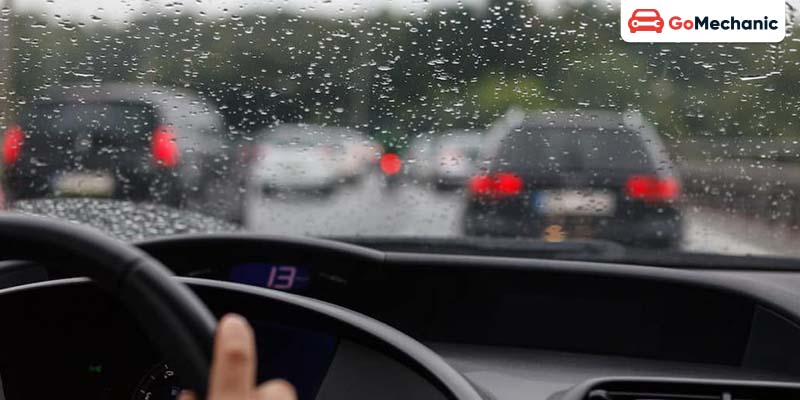Monsoon lovers get really happy when it starts raining as it allows them to have a fun and memorable driving experience. The relaxing sound of raindrops and the fresh fragrance of rainy roads can excite you to drive your vehicle and have the most thrilling experience. However, during this enjoyable experience, it is important to understand the cons that come along with driving in the rain. From maintaining a clear view to handling risks like slippery roads and decreased grip. Understanding these factors is crucial for your safety and maximizing the fun.
Here are some essential tips you should look forward to:
Understanding Rain’s Impact on Driving
It is important to understand the challenges of driving in the rain. It seems fun unless you face the risks. So here are some points which will help you to understand the impact on driving in the rain:

- Reduced Visibility: Rain reduces sight and makes it complicated to see the other vehicles on the road, including pedestrians and road signs.
- Slippery Roads: Wet roads decrease the grip of tires. When braking distances are longer, it increases the risk of accidents and high chances of skidding.
- Aquaplaning: The buildup of water on the road can cause the tires to lose grip on the road surface. Resulting in loss of control over excessive steering and braking.
- Use of Headlights: Always turn on the headlights in rainy weather, not just for your own sight but also to make your vehicle to be easily seen by others.
- Avoid Cruise Control: Maintain manual control regarding your vehicle’s speed and acceleration. So they can react quickly to changing road situations.
- Caution in Risky Areas: Be extra careful in areas where prone to flooding, landsliding, or stagnant water. As these can raise the risks of driving in the rain.
Precautions
There are no such risks if you take precautions before driving in the rain. Here are some precautions that are crucial to ensure safety on the road:
- Slow Down: Slow down your speed to adjust for wet and slippery road surfaces.
- Increase Following Distance: Maintain the gap between our car and the vehicle in front. So, that can you allow for longer braking distance.
- Check Tires: Ensure your vehicle tires have proper tread depth. Also, they are correctly inflated for better grip on wet roads.
- Use Headlights: Always turn on the headlights in rainy weather, not just for your sight but also to make your vehicle to be easily seen by others.
- Avoid Sudden Maneuvers: Make slow movements when steering, accelerating, and braking to maintain control.
- Stay Alert: Be active and pay your full attention to the road signs. Also, to the other vehicles to prepare for the changes and respond appropriately.
- Defog Windows: Keep your windows and windshield clean to keep your view clear.
- Avoid Cruise Control: Maintain manual control regarding your vehicle’s speed and acceleration. So they can react quickly to changing road situations.
- Watch for Aquaplaning: If you feel that your car is aquaplaning, reduce the pressure and steer straight until you gain control again.
- Be Cautious in Hazardous Areas: High level of awareness in areas where there are risks of flooding, landsliding, etc.
Checklist
Here is a rainy driving checklist for you to check the things are done or not! Some essential precautions and actions:
Tires
- Assure that tires have proper tread depth for better grip on wet roads.
- Check tire pressure to ensure peak performance on wet surfaces.
Speed and Following Distance
- Slow down the speed to adjust for wet surfaces.
- Maintain the gap to allow for longer braking distances.
Visibility
- Turn on the headlights, even during the daylight and light rain to improve sight.
- Make sure that windshield wipers are working and are operating properly.
Brakes
- Test brakes after driving through standing water to ensure they are in good condition and operating properly.
- Brake earlier with reduced force than usual to avoid slipping on wet roads.
Vehicle Control
- Avoid maneuvers; make slow movements when steering, accelerating, and braking.
- Deactivate cruise control to maintain better control, so they can react quickly to changing road situations.
Conclusion
In conclusion, driving in the rain can give a thrilling experience with the relaxing environment and fresh fragrance of wet rainy roads. However, it is crucial to know the challenges you can face while driving in the rain. From reduced visibility and using headlights to the checklist of tires, brakes, or vehicle control. Understanding these aspects is crucial for safe navigation. Outlines mentioned like, precautions of staying alert, defog windows or the checklist of speed and following distance, visibility can reduce risks and you can enjoy your rainy day. Remember all these tips not only for your personal safety but also to enhance the overall overall enjoyment of driving in monsoon weather. Understand the tips and make your each journey memorable and secure!






